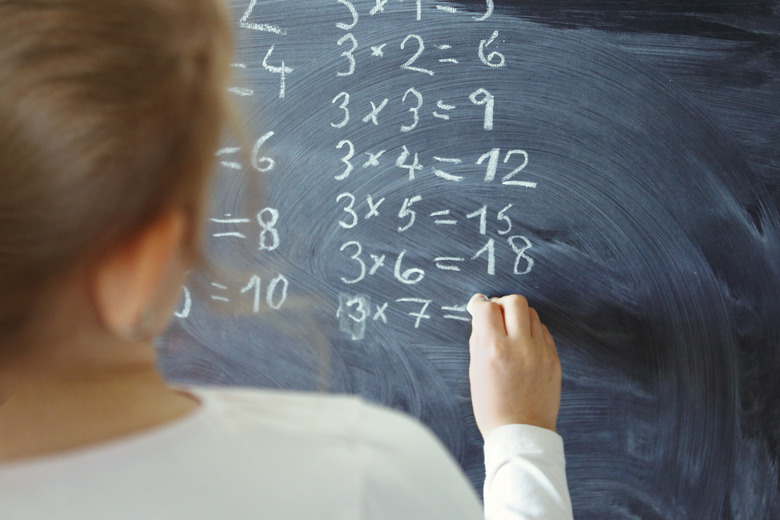How To Compare LCD & LCM In Fifth Grade Math
When first learned, math concepts like the least common multiple (LCM) and the least common denominator (LCD) might seem unrelated. They also might seem very difficult. But, like other math skills, practice helps. Finding the least common multiple of two or more numbers and the least common denominator of two or more fractions will be valuable skills in math lessons and classes in the future.
Defining the LCM
Defining the LCM
The smallest common multiple of two (or more) numbers is called the least common multiple or LCM. What is meant by "common?" Common in this case means shared or in common as a multiple of two (or more) numbers. For example, the least common multiple of 4 and 5 is 20. Both 4 and 5 are factors of 20.
Defining the LCD
Defining the LCD
The least common multiple of two or more denominators is called the least common denominator or LCD. In this case, the common multiple occurs in the denominator (or bottom number) of a fraction. The LCD needs to be calculated when adding or subtracting fractions. The LCD isn't needed when multiplying or dividing fractions.
LCM vs. LCD
LCM vs. LCD
The LCD and the LCM require the same math process: Finding a common multiple of two (or more) numbers. The only difference between LCD and LCM is that the LCD is the LCM in the denominator of a fraction. So, one could say that least common denominators are a special case of least common multiples.
Calculating the LCM
Calculating the LCM
Finding the least common multiple (LCM) of two or more numbers can be done using different approaches. Factorization offers a quick and effective method to find the LCM of two or more numbers.
Factor Check
When looking for the least common multiple, start by checking to see if one number is a multiple or factor of the other number. For example, when looking for the LCM of 3 and 12, notice that 12 is a multiple of 3 because 3 times 4 equals 12 (3 × 4 = 12). The LCM can't be less than 12 because 12 is one of the factors. (Remember that 12 times 1 equals 12 [12 × 1 = 12].) Since 3 and 12 are both factors of 12, the LCM of 3 and 12 is 12. Starting with this factor check will quickly solve some problems.
Factorization to Find LCM
Using factorization quickly and efficiently finds the LCM of two or more numbers. Practice the method using simpler numbers. For example, find the LCM of 5 and 12 by factoring each number. Factors of 5 are limited to 1 and 5, since 5 is a prime number. Factorization of 12 starts by breaking down 12 into either 3 × 4 or 2 × 6. The problem solution doesn't depend on which pair of factors is the starting point.
Starting with the factors 3 and 4, evaluate the factors of 12 further. Since 3 is a prime number, 3 can't be factored further. On the other hand, 4 factors into 2 × 2, prime numbers. Now 12 is factored into 3 × 2 × 2, and 5 is factored into 1 × 5. Combining these factors yields (3 × 2 × 2) and (5 × 1). Since there are no repeated factors, the LCM will include all the factors. Therefore, the LCM of 5 and 12 will be
\(3 × 2 × 2 × 5 = 60\)
Look at another example, finding the LCM of 4 and 10. An obvious common multiple is 40, but is 40 the least common multiple? Use factorization to check. First, factoring 4 gives 2 × 2, and factoring 10 gives 2 × 5. Grouping the factors of the two numbers shows (2 × 2) and (2 × 5). Since there is a common number, 2, in both factorizations, one of the 2s can be eliminated. Combining the remaining factors gives
\(2 × 2 × 5 = 20\)
Checking the answer shows that 20 is a multiple of both 4 (4 × 5) and 10 (10 × 2), so the LCM of 4 and 10 equals 20.
LCD Math
LCD Math
To add or subtract fractions, the fractions must share a common denominator. Finding the least common denominator means finding the least common multiple of the denominators of the fractions. Suppose the problem requires adding (3/4) and (1/2). These numbers cannot be directly added because the denominators, 4 and 2, are not the same. Since 2 is a factor of 4, the least common denominator is 4. Multiplying
\(\frac{1}{2} × \frac{2}{2} = \frac{2}{4}\)
The problem now becomes
\(\frac{3}{4} + \frac{2}{4} = \frac{5}{4} \text{ or } 1 \, \frac{1}{4}\)
A slightly more challenging problem,
\(\frac{1}{6} + \frac{3}{16}\)
again requires finding the LCM of the two denominators, otherwise known as the LCD. Using factorization of 6 and 16 yields the factor sets of (2 × 3) and (2 × 2 × 2 × 2). Since one 2 is repeated in both factor sets, one 2 is eliminated from the calculation. The final calculation for the LCM becomes
\(3 × 2 × 2 × 2 × 2 = 48\)
The LCD for
\(\frac{1}{6} + \frac{3}{16}\)
is therefore 48.
References
- Merriam-Webster Dictionary: Least Common Multiple
- Merriam-Webster Dictionary: Least Common Denominator
- Lamar State College-Orange: Fraction Facts
- Arkansas Tech University: Least Common Multiple
- Mesa Community College: Adding and Subtracting Rational Expressions
- Mesa Community College: Finding the Least Common Denominator
Cite This Article
MLA
Blaettler, Karen G. "How To Compare LCD & LCM In Fifth Grade Math" sciencing.com, https://www.sciencing.com/compare-lcm-fifth-grade-math-6172477/. 22 December 2020.
APA
Blaettler, Karen G. (2020, December 22). How To Compare LCD & LCM In Fifth Grade Math. sciencing.com. Retrieved from https://www.sciencing.com/compare-lcm-fifth-grade-math-6172477/
Chicago
Blaettler, Karen G. How To Compare LCD & LCM In Fifth Grade Math last modified August 30, 2022. https://www.sciencing.com/compare-lcm-fifth-grade-math-6172477/
